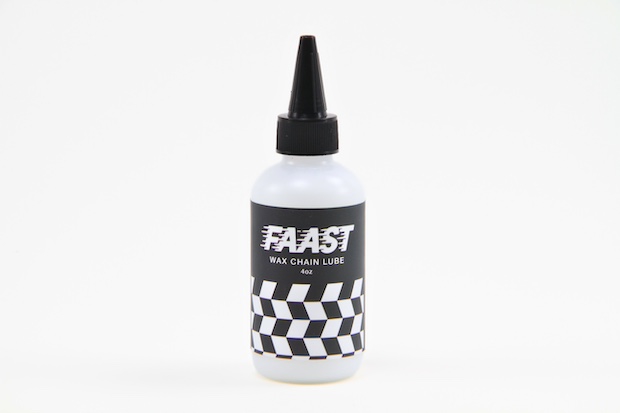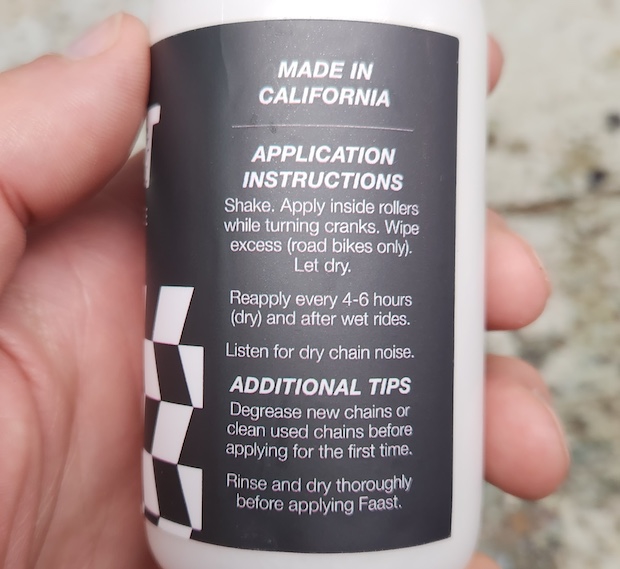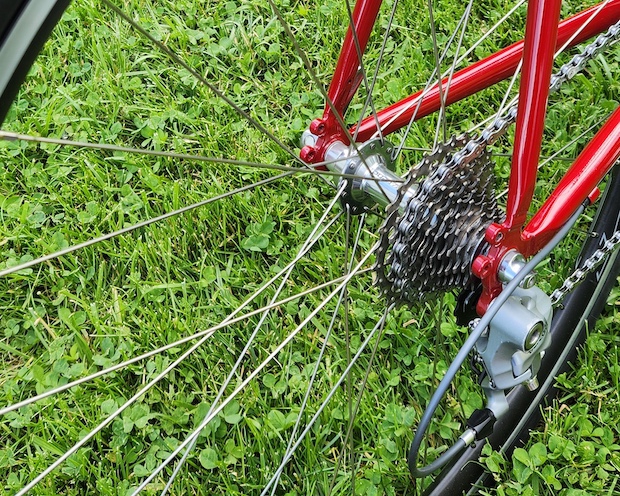Introducing FAAST Wax Lube

Meet Johnny and Colleen Vanderwell. The Southern California-based couple is passionate about introducing cycling enthusiasts to the benefits of using a wax-based chain lube. They aren’t necessarily setting out to compete with the wax lube you may already be using. Rather, they are on a mission to educate people and potentially convert them to chain maintenance with a wax lube.

Weary of the time-intensity of stripping and hot waxing chains, Johnny started experimenting with using wet wax chain lubes around two years ago. He had created his own hot wax mix with paraffin and Teflon and decided to make his own wet wax lube. In consultation with a chemist, Johnny has created over 200 test batches in his garage before arriving at the formula for FAAST.
As with all lubes, the goal is to get the lube “inside” the chain and not just on the surface of the plates. Ideally, the lube works its way into the rollers to help reduce friction. Too thick and the wax lube will remain on the surface of the chain. Too thin and the wax lube will drip off the chain without leaving enough wax behind inside the chain.
The Vanderwells combined Johnny’s experience as a bike mechanic and a garage chemist with Colleen’s background in operations working for non-profit organizations. The result of their combined efforts is the launch of the FAAST chain lube last fall and a steadfast commitment to grow their brand by educating cyclists about keeping their bikes clean and free of avoidable friction. FAAST connotes movement and helps share their message to “Keep Going” on and off the bike.
Testing
Johnny sent me a bottle of the first iteration of FAAST that they brought to market. To give it full consideration, I completely stripped a new chain of the manufacturers lubricant and applied the FAAST wax lube, one drop on each roller. After letting the chain dry, I did a short ride but wasn’t satisfied that I had enough wax lube on the chain because it was still squeaking a bit. After the second application and letting it dry, I had a silent and clean chain. However, I did find that I had to reapply wax lube every other ride.

Johnny was hearing similar anecdotes from his local riding community that uses FAAST wax lube. That initial batch was a bit too thin and wasn’t leaving enough wax behind. So, back to the chemistry lab in his garage, Johnny produced a slightly thicker formula. I’ve been using the thicker formula now for a couple weeks and find that I don’t have to reapply as often. More wax is in fact staying in the chain compared to the first iteration they brought to market.

Not all my bikes have waxed chains. I’m very much in alignment with Johnny’s thinking that wax lubes (and hot waxed chains) are better suited for dry conditions. Wax chains pick up less debris – they don’t produce the friction paste that petroleum-based lubes tend to do, especially if over applied. Any dry dirt collected by waxed chains tends to clump up and drop off, leaving you with a very clean looking and quiet chain.
However, waxed chains are not ideal in wet conditions. Your chain will rust if not dried off after a ride in the rain. Johnny suggests that wax lubes aren’t for you if you are planning to ride regularly in the rain. However, if you are only being caught in the rain occasionally, Johnny suggests that wax lube is viable but may need reapplied more often – even during the ride. FAAST will soon be available in 1 oz. bottles for this very purpose.

Following this line of thinking, I tend to use hot wax or drip wax lube only on my fair-weather bikes, namely my steel glam commuter, my indoor track bike, and the bike I have semi-permanently parked on the indoor trainer. For the rest of my road, gravel, cyclocross, and mountain bikes I use a petroleum-based wet lube.
Available Now
If you are in the wax curious category, FAAST is a great place to start. You are getting a tested product from the Vanderwells, who want to help you learn how to use wax lube not only to have a cleaner and more efficient chain but also to prevent unnecessary wear and tear on your bike’s expensive drive train.
You can purchase a 4 oz. bottle of FAAST wax lube for $18 on their website, as a single purchase or as a subscription with two-, four-, and six-month options. You can also purchase their wax lube on Amazon, if you need to replenish FAAST in two days with a Prime membership.
What’s Next?
I asked Johnny and Colleen what was next for FAAST Products. For now, they said their mission is education and helping more people learn to use wax lubricant appropriately on their bicycles. They suggested that most people who aren’t using wax don’t know that it may be a viable option for them.
Johnny shared that although it’s ideal to strip your chain before using FAAST wax lube, it’s not necessary. His testing has revealed that with regular application, the wax lube will replace the manufacturer’s lubricant on new chains over time.
The Vanderwells also shared that they are looking to partner with grassroots events and cycling enthusiasts who share a passion for educating people about bike maintenance and care.
There are so many squeaky chains out there that simply are not FAAST.




Start the discussion at forum.slowtwitch.com